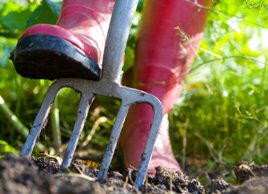4 fall gardening tasks
Cover, plant, transplant and compost your way to a gorgeous fall garden

‘I always look at fall as a great opportunity to give your garden a whole new look,’ says Carson Arthur, host of HGTV’s Green Force, a show that follows Arthur as he transforms dull urban spaces into environmentally friendly gardens. Here’s a checklist of what you should be doing with your bed this October.
1. Cover
Wrap your evergreens and rose shrubs with burlap, especially if they’re growing near a large deciduous tree, such as maple, oak or birch. ‘When all the leaves fall off these trees, nearby bushes will be exposed to full sun, and it’s too hard on them because they aren’t used to the direct sunlight,’ says Arthur.
2. Plant
Arthur suggests refreshing your garden with autumn annual plants such as purple fountain rye grass, flowering kale and icicle pansies. ‘The fall is an opportunity to change up the look of your garden, and add some new colour plus new texture.’ Map out your garden, he adds. This will help you remember where you planted your bulbs for next year (which means you won’t forget where they are and plant more next year, or dig up what you’ve already planted!).
3. Transplant
Start digging up and potting tender perennials, like canna lilies and geraniums, and move them indoors. Once the nighttime temperature drops below 10°C, these won’t survive. ‘The best conditions to transplant are when the soil is cool and wet,’ says Arthur. ‘The fall is also a great time for dividing plants, like hostas.’ Use a sharp shovel and cut right into them. Replant them in the garden right away or share with a neighbour.
4. Compost
When it comes to composting leaves, grass clippings, weeds and dead plants, Arthur suggests mixing these together to help them break down better, or using them as mulch to protect the soil over the winter. Just watch out for plant diseases such as powdery mildew (white snowy texture); if left to over-winter, they can destroy your garden during spring. Powdery mildew can also live in composters and survive easily over winter. Remove the affected plant from the garden, put it in a paper bag and tie it tight, then dispose of the bag.
Don’t miss out! Sign up for our free weekly newsletters and get nutritious recipes, healthy weight-loss tips, easy ways to stay in shape and all the health news you need, delivered straight to your inbox.




